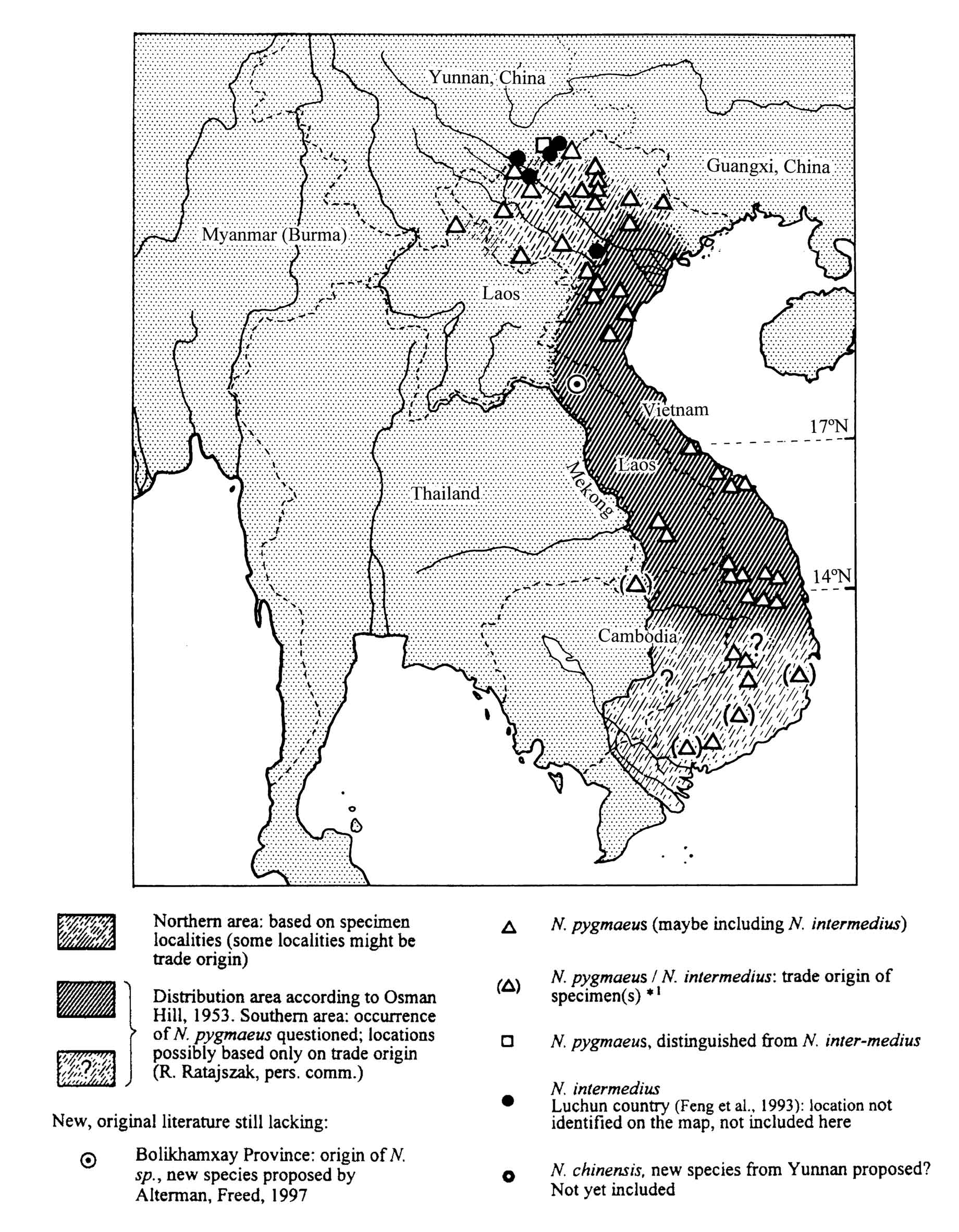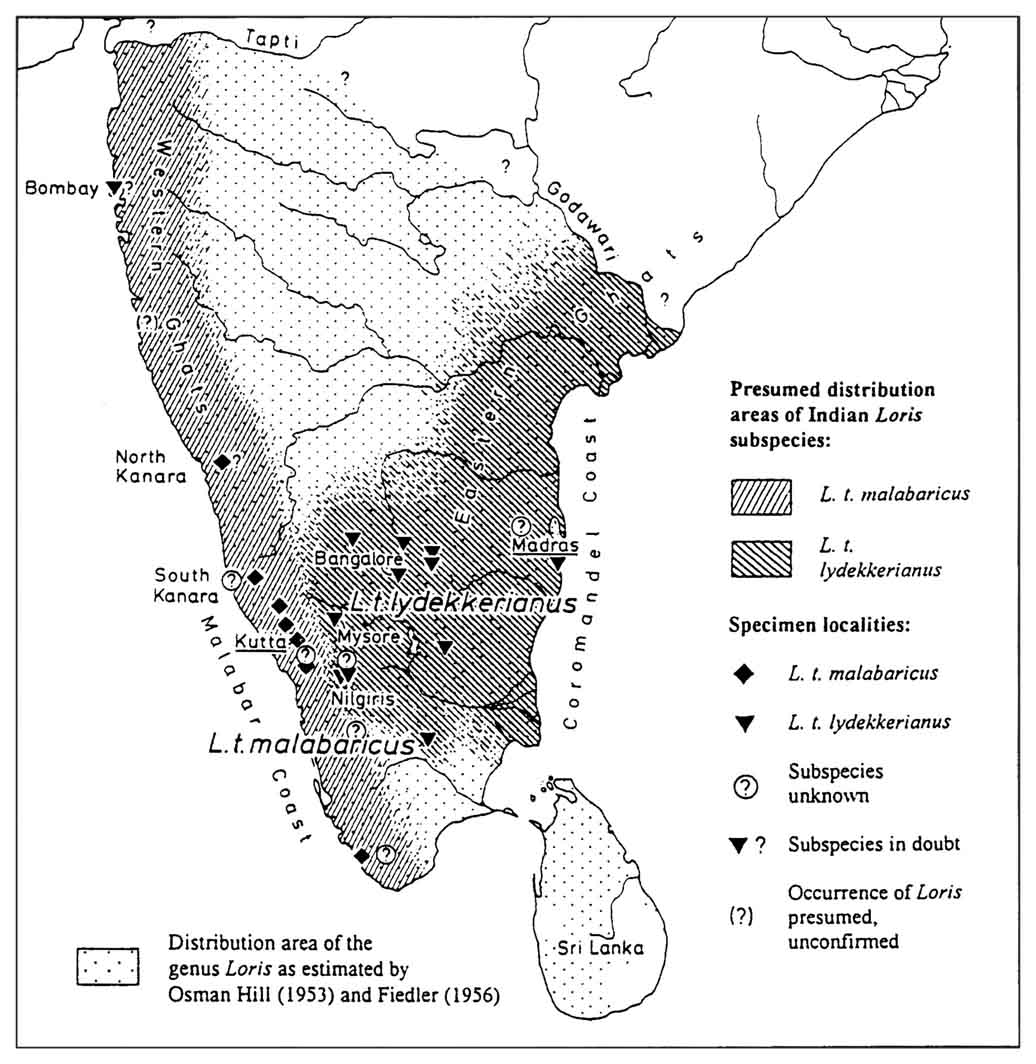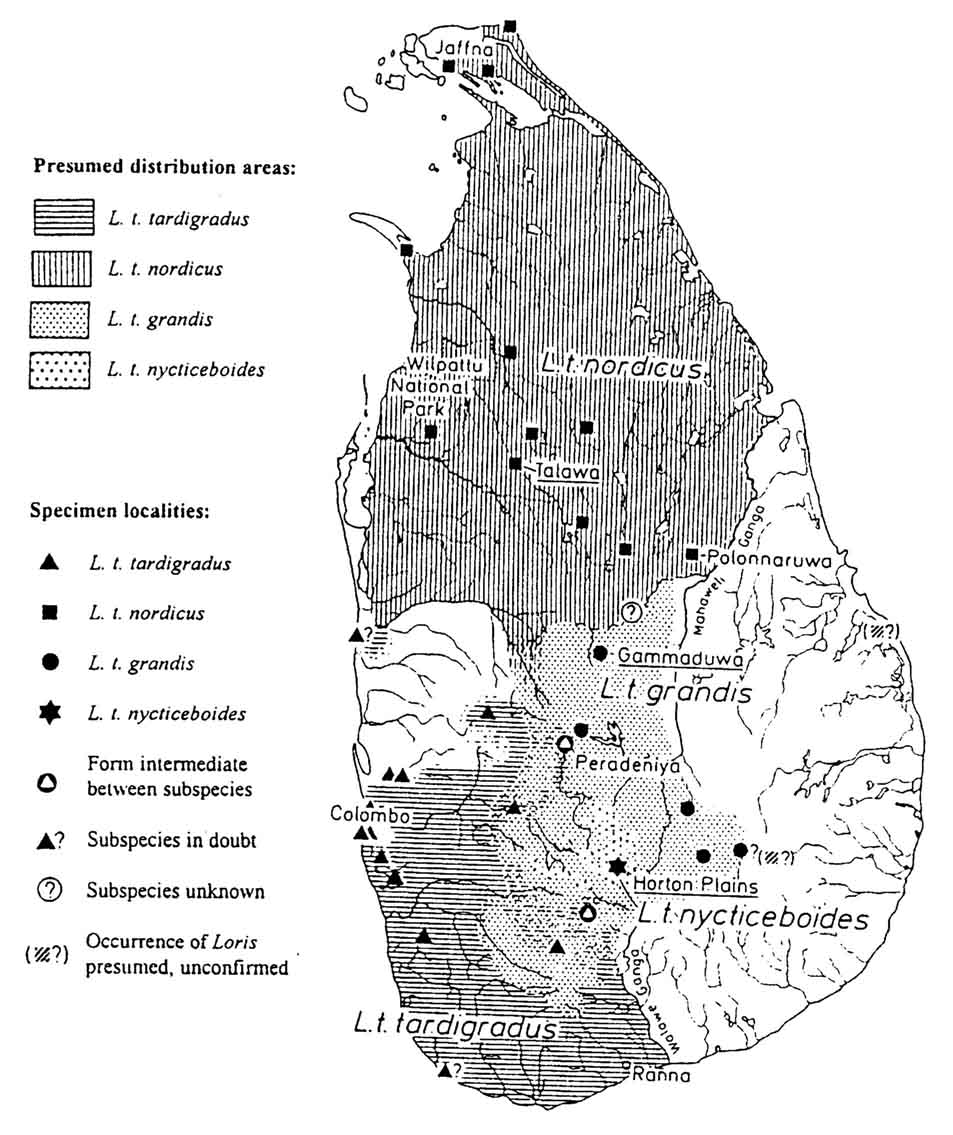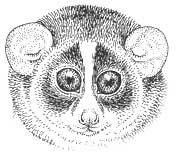
| Home |
|
|
Husbandry Manual for Asian Lorisines (Nycticebus & Loris ssp.)
DISTRIBUTION AND STATUS
Slow loris
Pygmy loris
Slender loris
HISTORY OF LORISES IN CAPTIVITY

Figure 9: Nycticebus coucang, distribution area and some specimen localities. (All areas mentioned as distribution areas by at least one author were included.) See Map References.
7
![]() Loris
Husbandry Manual
Loris
Husbandry Manual
The slow loris has a fairly wide distribution in Southeast Asia. It is found in India, Burma, Thailand, Vietnam, Laos, Cambodia, Malaya, Sumatra, Java, Borneo and some adjacent islands (Napier and Napier, 1967). Its distribution extends north into China where it occurs in southern Yunnan and western Guangxi (Zhang et al., 1992). There is limited information about population numbers of any of the Asian prosimians. MacKinnon estimated the population in Indonesia at 1,139,415 in 1987. This number was based on estimates of suitable remaining habitat and population density at that time, and only 14% of the suitable habitat was protected as reserves. Undoubtedly, the present population is much smaller.
N. coucang occurs in primary and secondary rain forests. Besides habitat destruction, the slow loris is at risk due to illegal trade and hunting (MacKinnon, 1987). Their fur is used as dressing for wounds by natives from Burma to Borneo (Harrison, 1962). Thadou tribesmen believe that the slow loris flesh can cure epilepsy and its meat can cure stomach ailments.
As is true for all the Asian prosimians, field research is difficult due to lorisesí nocturnal, arboreal, cryptic nature (some Internet information about field methods is available under http://www.species. net/Primates/Loris/LorCind.html). The Global Captive Action Plan for Primates (Stevenson et al., 1992) recommends that well-managed captive nuclei of two subspecies (coucang and bengalensis) are kept. They do not consider the species to be in danger of extinction in the near future, so conservation efforts have therefore been limited. The Prosimian Taxon Advisory Group has recommended a moratorium on captive breeding efforts in North America to ensure sufficient space for more critical species such as the pygmy loris.
Distribution of the pygmy loris is predominantly the evergreen forests of Vietnam and Laos. Duckworth (1994) found that slow and pygmy lorises are sympatric in some areas of Laos. Pygmy lorises are also found in the secondary forests and shrub land of Vietnam (Ratajszczak, 1988). Qiang et al. (1987), have reported that the pygmy loris additionally occurs in the Yunnan province of China. Due partly to unstable political situations in the countries where these animals originate, little is known about their wild status. The total population has been estimated at 72,720, with less than 13% occupying protected areas (MacKinnon and MacKinnon, 1987). Because of a 76% habitat loss from logging, along with destruction from military activities and hunting, the pygmy loris is considered to be under-protected in the wild (MacKinnon and MacKinnon 1987).
Pygmy lorises are often kept as a domestic pet and are sold in local markets in Vietnam and Laos (Ratajszczak, 1988). The eyes, fur, and other parts of the body are also used for medicinal purposes. A survey of the Ho Chi Minh City animal market in January 1994, found 43 pygmy lorises for sale (Tan, 1994).
The IUCN Species Survival Commission in its 1994 Red List of Threatened Animals has classified Nycticebus pygmaeus as vulnerable. Vulnerable is defined as taxon that are facing a high probability of extinction in the wild in the medium-term future. The Global Captive Action Plan for Primates (Stevenson et al. 1992) proposes a breeding program that has a population sufficient to preserve 90% of the average heterozygosity of the wild gene pool for 100 years. A Species Survival Plan was established for the pygmy loris in 1994.
8

Figure 10: Distribution of Nycticebus pygmaeus and possibly existing other pygmy loris forms.
Forms distinguished from N. pygmaeus by some authors are here included under the names / synonyms used in the literature. The question of correct taxonomy is not intended to be answered here. See Map References.
9
![]() Loris
Husbandry Manual
Loris
Husbandry Manual

Figure 11: Distribution of slender loris subspecies in India. Names of type localities are underlined. See Map References.
10

Figure 12: Distribution of slender loris subspecies in Sri Lanka. All areas mentioned as distribution areas by at least one author were included. See Map References.
The slender loris occurs in forest and woodland habitats (Mohnot 1980) and in thorny scrub jungle of the dry zones (B. Meier, pers. comm.). Mohnot reported in 1980 that the slender loris is uncommon; Hill commented in 1933 on its rarity in Sri Lanka. This species was frequently used in Indian laboratories for biological and biomedical research, but is now rarely used due to non-
11
![]() Loris
Husbandry Manual
Loris
Husbandry Manual
availability and shrinking population numbers. The slender lorisesí distribution is often patchy. It is still hunted in India because it is believed to cure eye diseases and is also believed to be a potent love charm (Devaraj Sarkar et al., 1981). Sri Lankans also kill the animals for superstitious reasons (Schulze and Meier, 1995a, S. Verner-Carlsson, personal communication). Ramakantha (1991), reports that Marring Nagas grind the slender loris skull, mix it with water, and take it orally to cure epidemics like cholera.
Five subspecies (tardigradus,
grandis,
malabaricus, nycticeboides, and nordicus) are recommended
for breeding
programs by the Global Captive Action Plan for Primates (Stevenson
et al.,
1992). Present captive population numbers in Europe and North
America will
require periodic importation from the wild to attain a
satisfactory level
of genetic diversity.

12

13
|
Management
of Lorises in Captivity. A Husbandry Manual for
Asian Lorisines (Nycticebus
& Loris ssp.)
Edited by: Helena Fitch-Snyder and Helga Schulze. Compiler: Lena C. Larsen |
Last
amendment: 2 January 2003
|